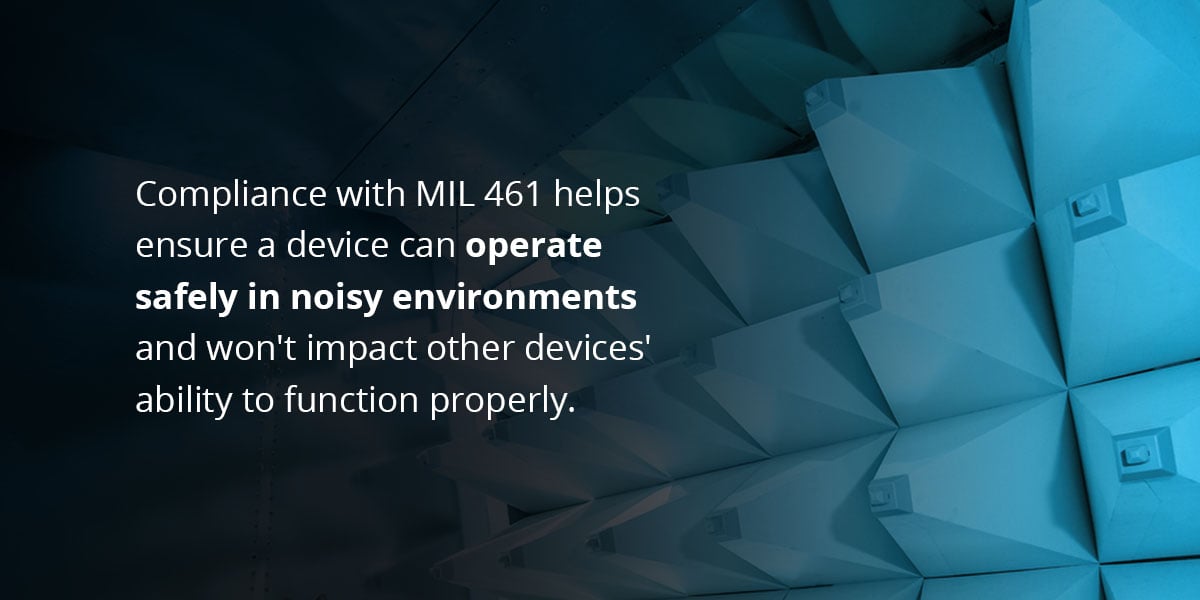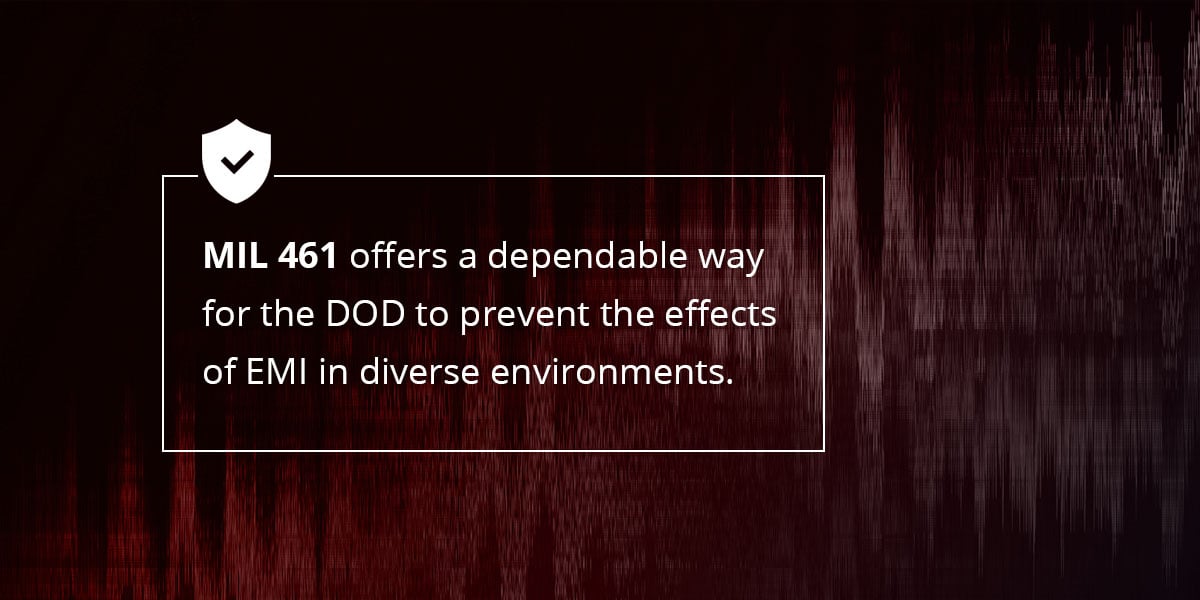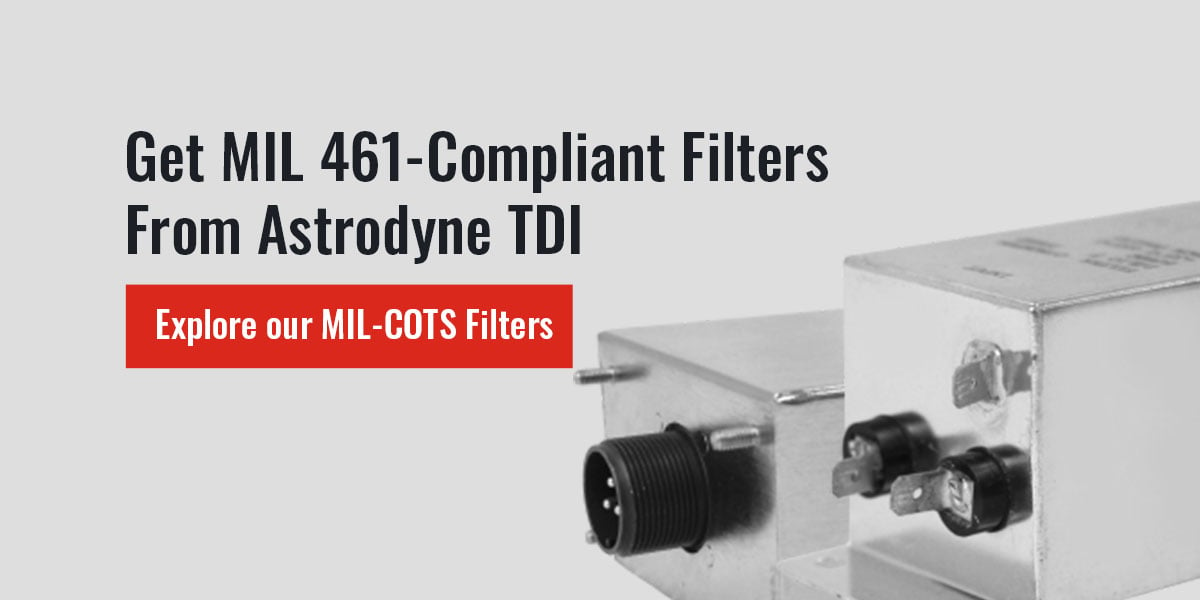RESOURCES
MIL 461 Compliance
Failure isn't an option in military operations, and electromagnetic interference (EMI) can cause many problems for mission-critical electronics that put operations at risk. Military Standard 461 (MIL-STD-461 or MIL 461) helps control electromagnetic (EM) energy and ensures that military equipment can work as intended in these environments. Before using electrical systems for military applications, you must ensure compliance with MIL 461 and its rigorous testing process.
What Is MIL 461 Compliance?
MIL 461 is a set of military standards applied to electronic systems and subsystems used by the United States Department of Defense (DOD). Many devices used in DOD activities must meet these standards, which assess how much EMI the product releases and receives.
All electronics operate on electromagnetic energy and release a small amount of it. This energy also exists in nature, such as in storms or solar flares. When energy from other sources, either human-made or natural, reaches an electronic device, it can interrupt the EM waves. With the high stakes of military operations and the sensitivity of their environments, malfunctions pose significant risks. The goal of MIL 461 is to block these signals from reaching and propagating from a system so the electronics will work as intended.
After passing a rigorous testing process for MIL 461, a product can be considered compliant and used in relevant military applications. This standard applies to a broad range of electronic systems, from those used in ground vehicles to aerospace. Some examples include:
- Communication systems: From radios to satellite-based systems, communication technologies must span long distances and work in demanding electromagnetic environments.
- Radar systems: Many military operations use radar for surveillance and tracking. Accurate readings depend on properly functioning equipment.
- Flight and naval systems: Ships and aircraft use a wide range of navigation, control, and communications systems to conduct operations and safely reach their destinations. Naval equipment often has its own separate standards to meet within MIL 461.
- Aerospace systems: Equipment used in space must work properly in one of the most difficult electromagnetic environments, where EMI is intense.
These are just a few examples of the equipment that must meet MIL 461, but the requirements can apply to almost any device. The DOD recommends this military EMI standard for discrete wiring harnesses between enclosures used as electrical interconnections, electronic enclosures smaller than an equipment rack, and electrical power inputs derived from prime power sources.
Although the military created and currently uses MIL 461, many other organizations and countries also use it. It's been around since the mid-1900s and continuously refined, so these other entities often turn to MIL 461 as a reliable, standardized way to measure EMI.

Why Is MIL 461 Compliance Important?
EMI is all around us, and military systems must operate in some of the most challenging environments. Susceptibility to these signals creates a significant vulnerability, increasing the potential for disruptions, security issues, or complete shutdowns. When safety and security are on the line, compliance is essential. EMI can affect equipment in many different ways, causing problems like:
• Power interruptions: Some systems might deliver less power or flicker if they experience EMI. From the lights on aircraft to a vehicle control system, interruptions cannot occur on mission-critical equipment.
• Shutdowns: Powerful EMI or EMI that affects sensitive equipment can lead to a complete shutdown of the equipment. Today's military tasks depend on many electronics, and a shutdown for any one of them could lead to mission failure or other adverse operational effects.
• Data loss: When interruptions occur at data centers or to equipment storing or transferring information, they can cause the loss of sensitive data.
• Security risks: Interference with security systems may lead to significant safety and security risks. Adversaries could use electronic warfare to shut down or intercept military security systems by exploiting EM susceptibility.
• Compatibility: Military equipment uses more devices than ever, and MIL 461 helps ensure all of these devices can safely communicate with each other. This standard supports easier interoperability across military tasks.
Malfunctioning equipment creates unpredictable risks for civilians and military personnel. With high-stakes applications and the increasing amount of electronics used in daily operations, electromagnetic compatibility (EMC) — the ability to function properly in environments with EMI — is crucial in defense. MIL 461 offers a dependable way for the DOD to prevent the effects of EMI in diverse environments.

MIL 461 Compliance Testing
To make sure electronic systems can offer the appropriate EMC, MIL 461 requires a strict testing process. Accredited labs conduct tests across these four sections, with individual tests selected according to the system's intended application environment:
- Conducted emissions: Conducted emissions testing assesses how much EM energy the system creates and conducts through a physical connection, such as a power cable or interconnection cabling.
- Radiated emissions: This test measures how much EMI the device releases into the free air as an electrical field. If too high, this EMI could impact operation for other nearby systems. Radiated emissions can travel far and spread outward.
- Conducted susceptibility: A conducted susceptibility test evaluates how vulnerable the device is to conduct emissions. In-line filters and other components can protect a system from these signals.
- Radiated susceptibility: Lastly, radiated susceptibility tests measure how well the system blocks radiated emissions from nearby devices or natural sources. Filters can help here, too, along with appropriate material selection.
Passing these tests isn't always straightforward. The requirements can be difficult to meet, and you won't always know what changes you'll need to make to pass. Plus, you might be pursuing multiple types of compliance testing at once. The right equipment is crucial to minimizing costs and meeting production timelines. Filters designed for EMI suppression are a common first line of defense against EMI.
Consider simplifying the process with our pre-compliance testing services. We can test your product to similar standards to reduce the risk of failing the military compliance testing. If your device doesn't pass, our knowledgeable engineers can step in to help you make the right changes.
Get MIL 461-Compliant Filters From Astrodyne TDI
MIL 461 compliance is a non-negotiable for systems used in military operations. To meet these strict requirements, you need the right components. Astrodyne TDI has been a trusted provider of commercial off-the-shelf (COTS) and customized filters for over two decades. We build our AC and DC filters to exceed demanding military standards, even in complex environments. Our expert team can help you find the right filters for your device and pass compliance testing with flying colors.
Explore our MIL-COTS filters online, or reach out to us to talk to an expert about your application.


